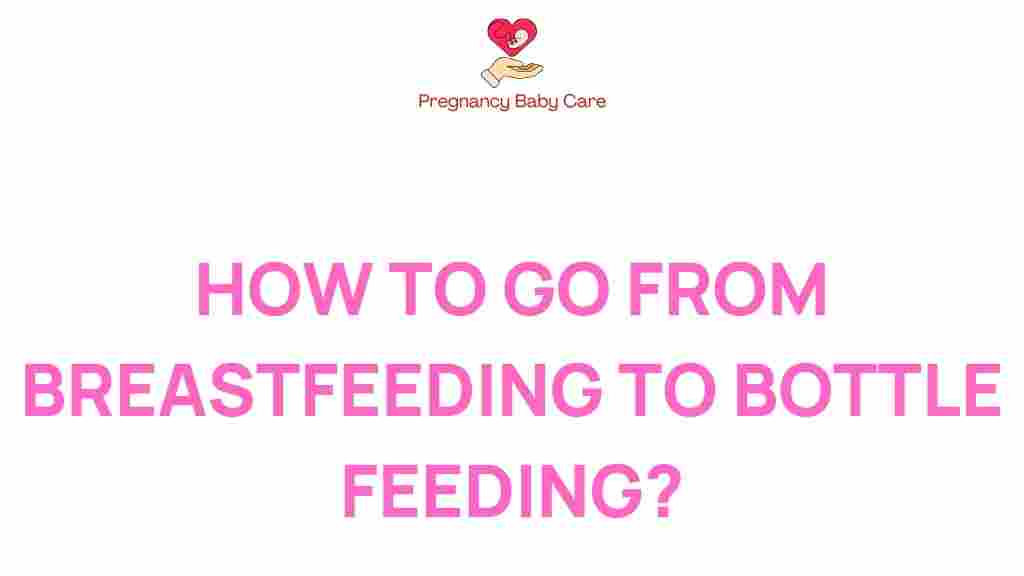Transitioning from breastfeeding to bottle feeding is a significant milestone in an infant’s life and a pivotal moment for parents. Whether you’re planning to return to work, seeking more flexibility in your feeding routine, or simply want to introduce your baby to different feeding methods, understanding the nuances of this transition is crucial. In this article, we’ll explore effective strategies for making this change smoothly while ensuring your baby receives the best nutrition possible.
Understanding the Basics of Infant Nutrition
Infant nutrition is foundational for your baby’s growth and development. Breastfeeding is often recommended for the first six months of life, but as your baby grows, introducing bottle feeding can be beneficial. Here are some key points about infant nutrition:
- Breastfeeding: Provides essential nutrients and antibodies that help protect against infections.
- Formula Feeding: An alternative that offers a balanced nutritional profile when breastfeeding is not possible.
- Combination Feeding: A mix of breastfeeding and bottle feeding, allowing flexibility and convenience.
Preparing for the Transition
Before you start the transition from breastfeeding to bottle feeding, it’s important to prepare both yourself and your baby. Here’s how you can effectively navigate this change:
- Choose the Right Time: Look for a moment when your baby is healthy and not experiencing any major changes in their routine.
- Select the Right Bottle: Experiment with different nipples and bottles to find one that your baby prefers. Some babies prefer softer nipples that mimic the feel of breastfeeding.
- Maintain a Routine: Try to introduce bottle feeding during a calm period of the day when your baby is relaxed and receptive.
Step-by-Step Process for Transitioning
Transitioning from breastfeeding to bottle feeding can be broken down into manageable steps. Follow this guide to make the process smoother:
Step 1: Introduce the Bottle Gradually
Start by offering the bottle when your baby is calm and not very hungry. You can try:
- Offering the bottle during a feeding session where your baby is already familiar with breastfeeding.
- Having someone else offer the bottle to minimize confusion; babies often prefer the breast when they can smell their mother.
Step 2: Experiment with Different Milk
You can start with breast milk in the bottle. Once your baby is comfortable with the bottle, you can gradually introduce formula if needed. Ensure any formula you choose meets your baby’s nutritional needs.
Step 3: Create a Comfortable Feeding Environment
Make feeding time a relaxed experience. Hold your baby close, maintain skin-to-skin contact, and try to mimic breastfeeding positions. This will help your baby associate the bottle with comfort and security.
Step 4: Gradually Increase Bottle Feedings
Once your baby has successfully taken a few bottle feedings, start to replace breastfeeding sessions with bottle feeds gradually. This slow approach will help your baby adjust without feeling overwhelmed.
Step 5: Monitor Your Baby’s Response
Keep an eye on how your baby responds to bottle feeding. Look for signs that they are satisfied and getting the nutrition they need. If they seem resistant, take a step back and give it more time.
Feeding Tips for Successful Transition
Here are some additional feeding tips that can aid in the transition from breastfeeding to bottle feeding:
- Stay Patient: Every baby is different. Some may adapt quickly, while others may take longer to accept the bottle.
- Stay Consistent: Regularity is key. Try to establish a routine that your baby can anticipate.
- Be Mindful of Temperature: Some babies prefer warm milk, while others don’t mind it cold. Experiment with temperature to find what works best for your baby.
- Seek Help if Needed: If you encounter difficulties, don’t hesitate to reach out to a pediatrician or lactation consultant for advice.
Troubleshooting Common Challenges
Even with the best preparation, you may encounter challenges during the transition. Here are some common issues and solutions:
Refusal to Accept the Bottle
If your baby refuses the bottle, try:
- Changing the bottle or nipple type.
- Offering the bottle at different times of day.
- Having someone else offer the bottle, as mentioned earlier.
Spitting Up or Gas Issues
Should your baby experience discomfort after bottle feeding, consider:
- Ensuring proper positioning during feeding.
- Burping your baby more frequently.
- Trying different formulas if switching from breast milk.
Emotional Resistance
Some babies may show signs of distress during the transition. To ease their anxiety:
- Keep the environment calm and nurturing.
- Offer reassurance and comfort during feedings.
- Don’t rush the process; take breaks if needed.
Conclusion: Embracing the Change
Transitioning from breastfeeding to bottle feeding is a journey that requires patience, understanding, and care. Each baby is unique, and their response to this change will vary. By following the steps outlined in this article and utilizing the feeding tips provided, you can navigate this transition with confidence.
Remember that your baby’s health and happiness are paramount. If you have any concerns about your baby’s nutrition during this transition, consult with your pediatrician or a lactation consultant. For more parenting advice and resources on early childhood care, visit our parenting blog.
With love and support, you can master this transition and provide your baby with the nutrition they need for a healthy start in life.
For additional information on infant nutrition, check out this resource here.
This article is in the category Feeding and created by PregnancyBabyCare Team
